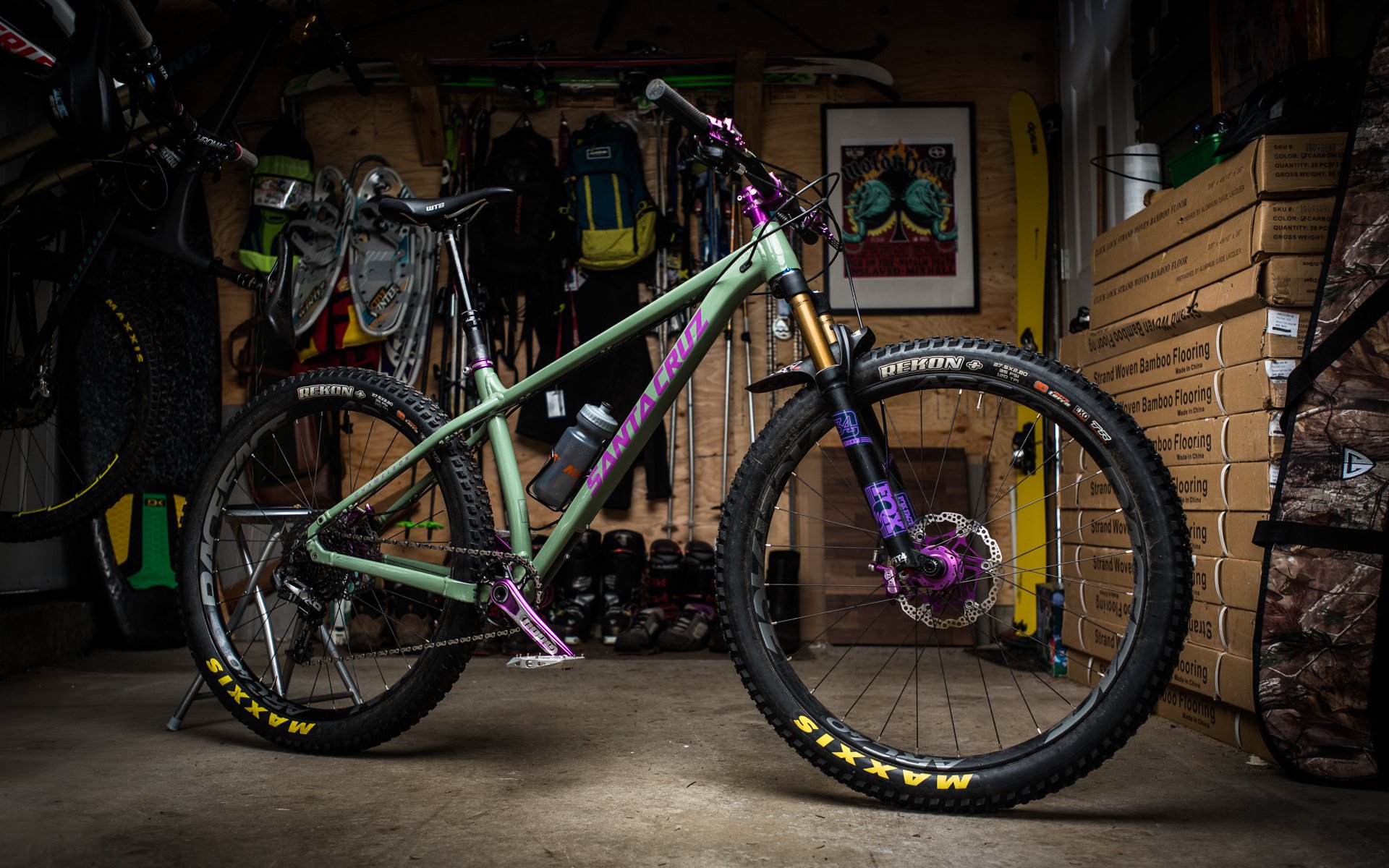
First Look and Early Ride Thoughts
2017 Santa Cruz Chameleon
The New Chameleon
The new Santa Cruz Chameleon has a lot going on - for a hardtail. It's slack; it's light; it's surprisingly smooth in the rough. There's tonnes of tire clearance for a 29" or 27+ wheel with short chainstays. It has rotating dropouts that make it simple to single speed with a rear center adjustable from 415mm to 430mm.
The aluminum frame has highly formed tubing with a stiff and compact front triangle and a surprising amount of damping out back. All the Santa Cruz features that prove their sanity are present: threaded BSA bottom bracket shell, external brake cable routing, clean internal shift cable routing and a unique paint job.
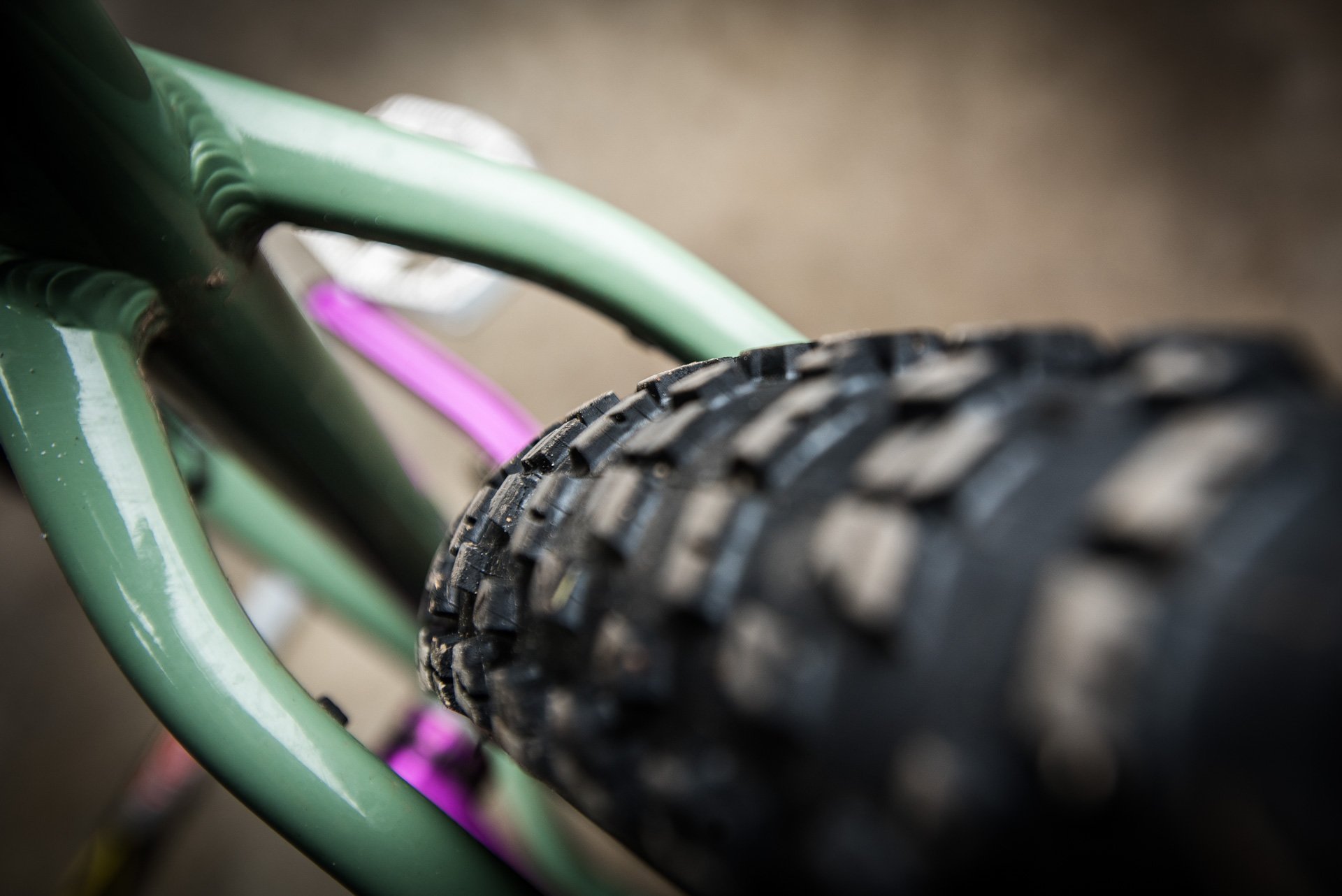
The Santa Cruz Chameleon has no chainstay or seatstay brace which helps with tire clearance (27+ & 29er) and gives it a surprising smooth ride. Especially for a bike with such a short rear center.
First Look
Santa Cruz is offering two complete builds for the Chameleon. Both bikes are built around SRAM's starting price-point NX 1x groupset and available with 29" or 27+ wheels.
The base model 'D' Kit features a RockShox Recon Silver fork, an NX 11-42 tooth drivetrain and SRAM Level brakes for $1599 (USD). The 'R' Kit sports a Fox Rhythm fork, a 10-42 (XD driver) drivetrain and Level T brakes for $1999 (USD). The 27+ models sport 2.8 Maxxis Rekon tires. The 29er models run a Maxxis DHF up front and a Crossmark II out back.
All the build kits come 1x with a 30t ring up front but the Chameleon does have provisions, and clearance, to run a front derailleur.
The Chameleon will also be available as a frame only to build as you'd choose. I have a couple of rides on Santa Cruz's own custom all-the-purple Hope build. It's got Hope brakes, Hope rotors, Hope cranks, Hope hubs, Hope headset, Hope stem, and a Hope bar.
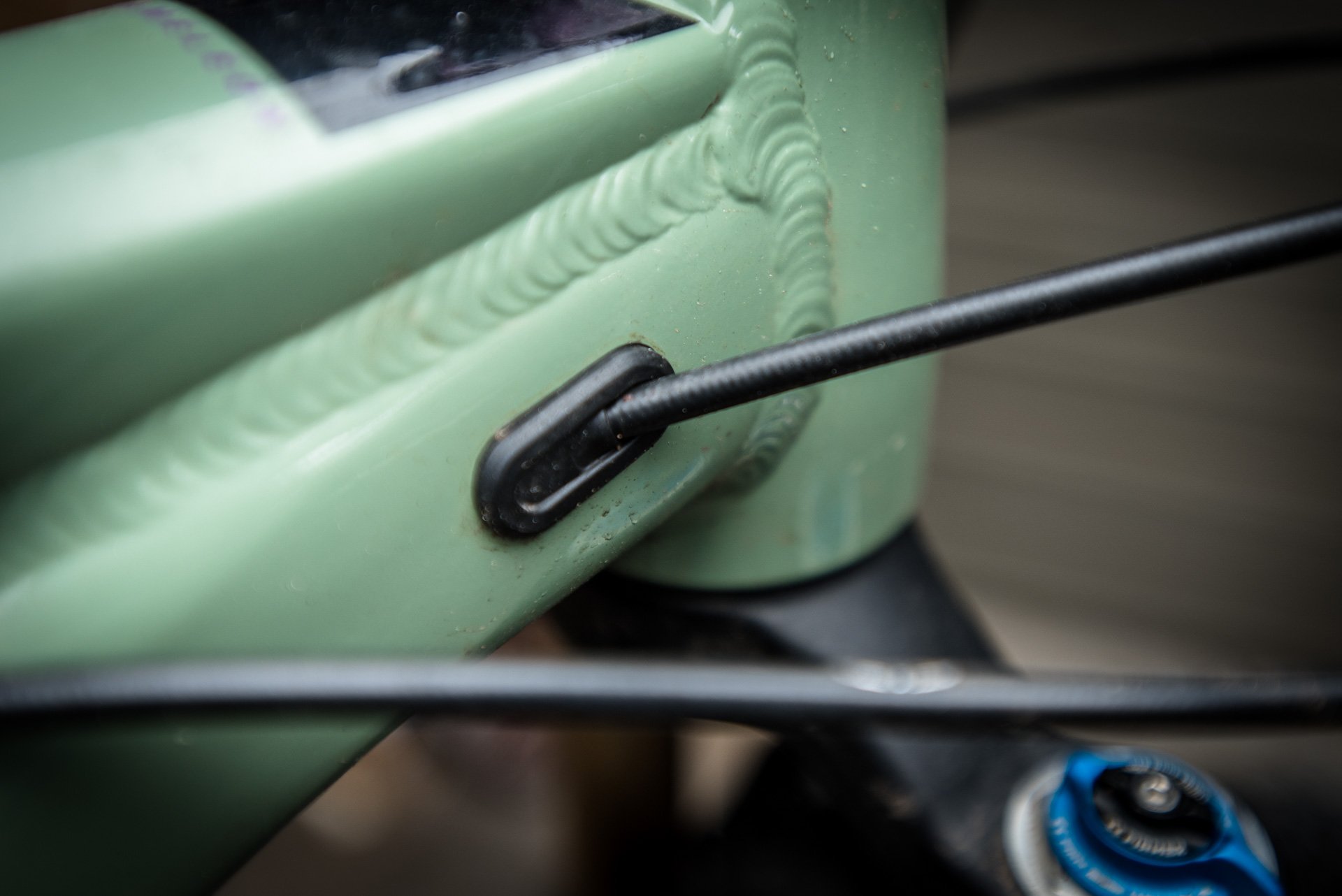
The Chameleon has external brake routing, a threaded BSA 73 bottom bracket shell, and Santa Cruz's well considered internal shift routing.
Geometry
To say the geometry is close to my 2013 Kona Honzo is an understatement. That's one hundred percent a compliment. It's a longer, slacker, Santa Cruz. There are only so many ways to skin a hardcore hardtail.
With a 120mm fork, Santa Cruz lists the Chameleon's head tube angle as 67.3° with 29" wheels and 67.6° with 27+ wheels. The 29er sports a 72.8° seat tube angle and the 27+ is listed at 73.1°. With 29" wheels the BB drop is listed at 55.2mm and with the 27+ they list it at 50.39mm. The frames use easily swappable wheelsize specific dropouts in order to maintain geometry with both sizes of hoops.
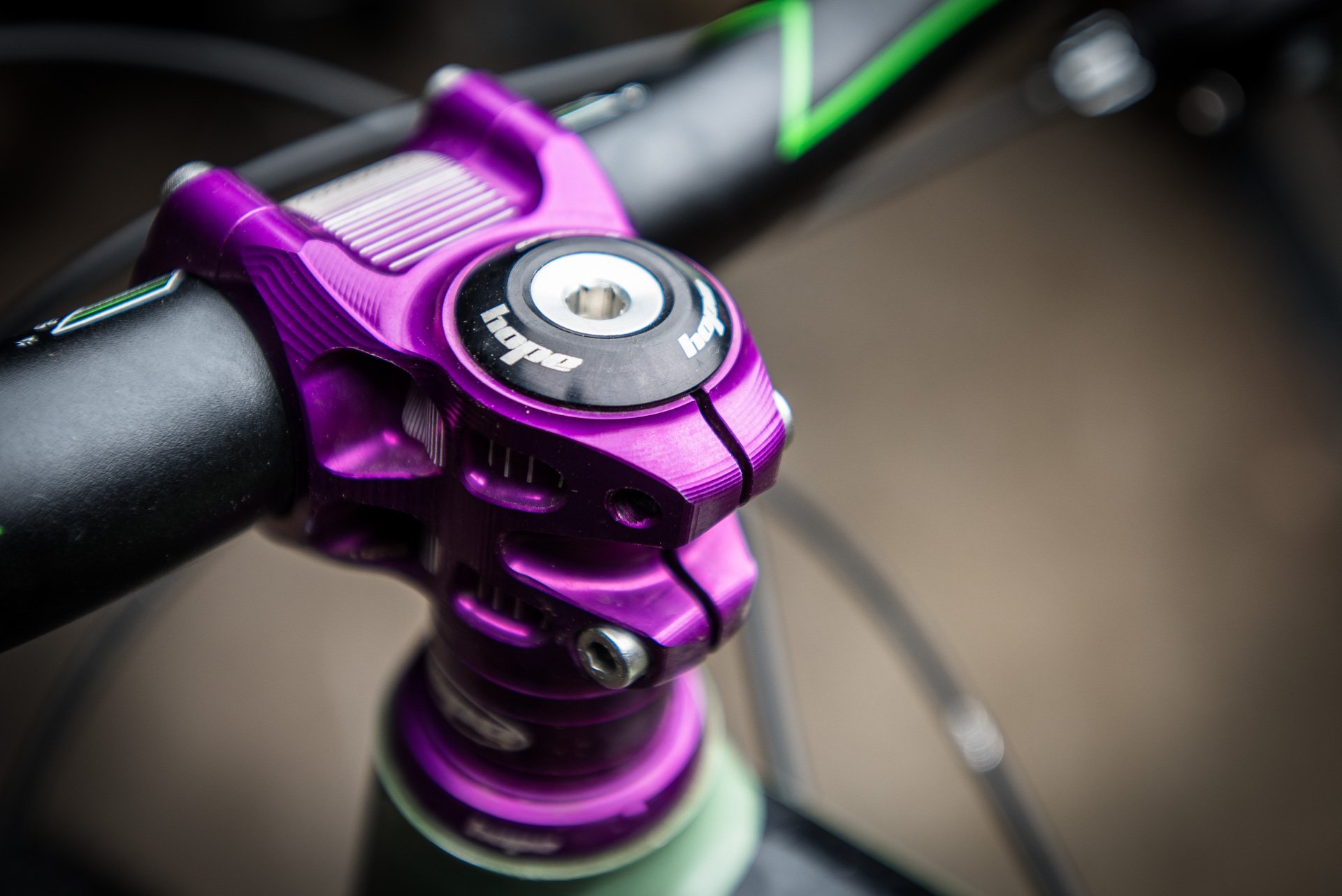
The control room on the custom Chameleon consists of a Hope bar, purple Hope stem, purple Hope headset and a set of purple Hope E4 brakes.
There will be some variation in angles as the Chameleon's adjustable dropouts operate off a pivot point as opposed to sliding horizontally. As the wheelbase extends from 415mm to 430mm the BB height will get lower and the STA and HTA will get a bit slacker.
There will also be some variation depending on the length of fork you choose. The custom Chameleon I rode had a 130mm Fox Float with their lightly valved FIT4 damper. If it was my bike I would definitely be increasing the travel to 140mm for the slight increase in BB height and a 1/2 degree slacker HTA.
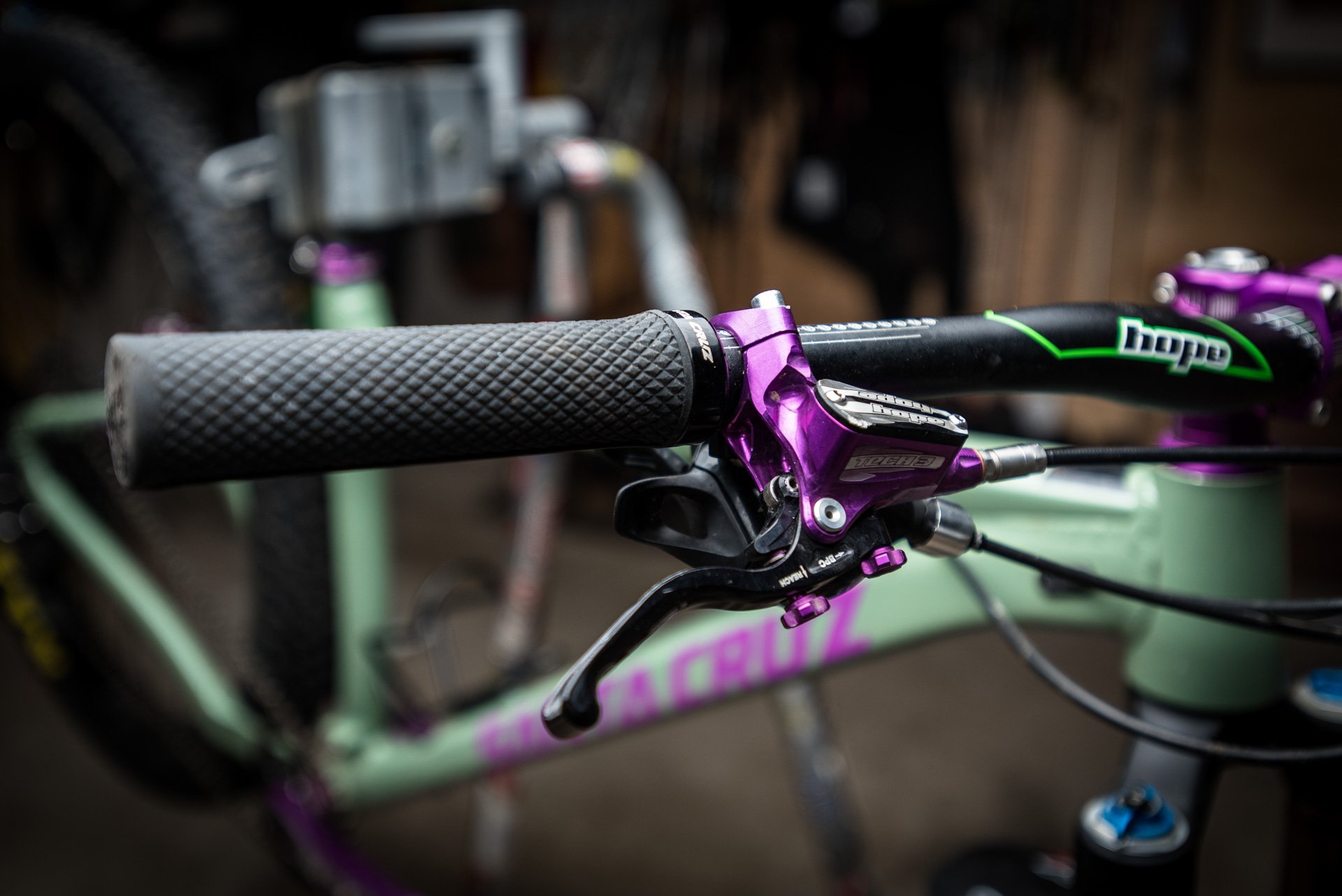
As per usual Hope's anodizing was all a perfect match and it worked very well with the stock purple-on-matte-green finish of the Chameleon. I love anodized purple but this was just a bit over the top even for my tastes.
The headtubes and stack are a bit short for my personal liking. A large Chameleon checks in at 100mm and the XL only jumps another cm to 110mm. Even with a longer fork, I'd personally prefer to see larger stack numbers than 615mm for the large and 625mm for the XL to go with the longer reach numbers that Santa Cruz is using for this platform.
That said, I don't hate the aesthetics of a large-rise bar and it seems that every company on the market is selling a 30mm+ rise option again. Likely for this reason.
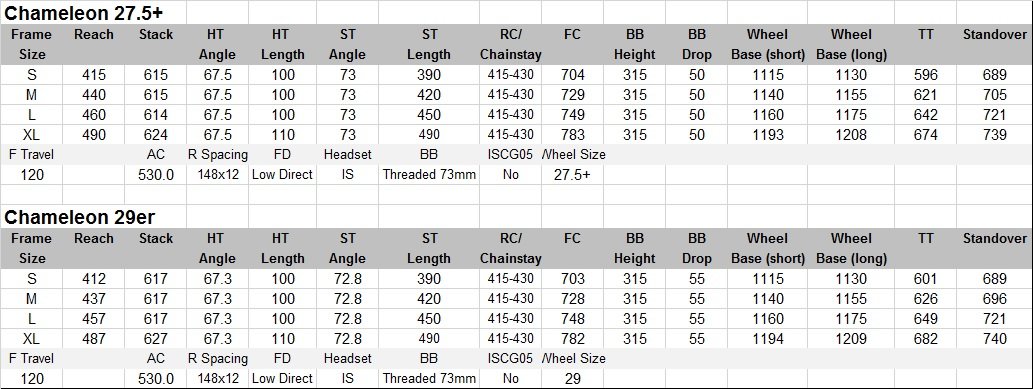
The V7 Santa Cruz Chameleon Geometry Chart.
The Ride
I've owned and ridden a huge variety of hardtails from carbon XC race machines to the 7lbs+ painted frame of my steel Honzo. There's lots of aluminum on my resume. What can I say after a couple of rides? The Chameleon is full of surprises.
Whether hammering on the 780mm bar out of the saddle or dropping into something steep while hard on the Hope E4 brakes, the compact front triangle is stiff and confidence inspiring. On the other hand, the rear end is surprisingly forgiving for a bike with short stays in general and an aluminum bike in particular. I attribute this to the lack of a seatstay brace or massive chainstay-BB yoke.
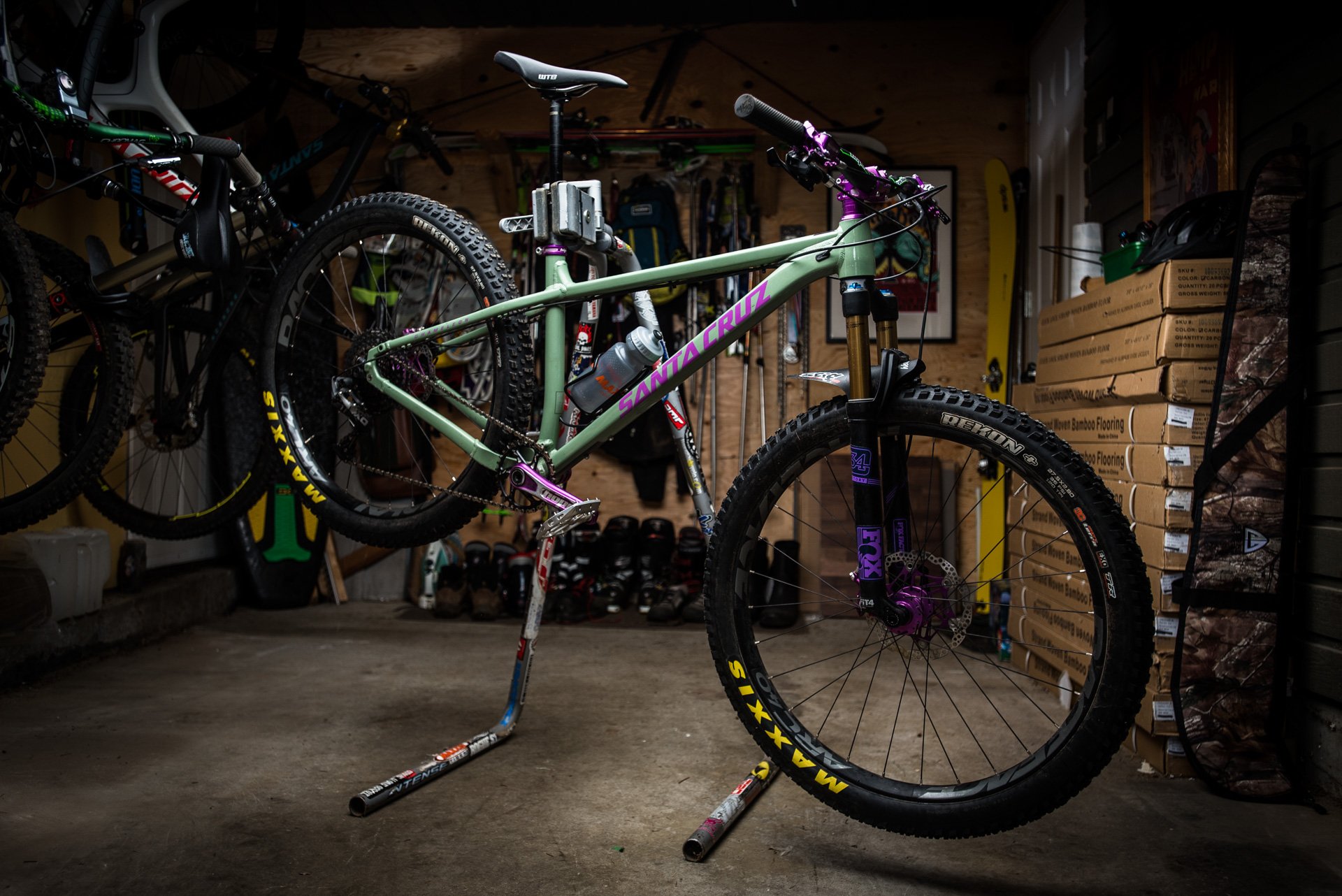
The front triangle is compact and stiff; inspiring confidence when hard on the brakes or reefing on the bar while out of the saddle. The rear end is surprisingly comfortable for an aluminum frame with short stays, likely due to the lack of a seatstay bridge or massive chainstay-BB yoke.
Repeat claims about carbon's 'vibration damping' or shout 'STEEL IS REAL!' enough times and it will seem to be true. The fact is that material is just one part of the design process. The 2017 Chameleon isn't a Banshee Morphine, or even a past example of the Chameleon, and combined with 29er or 27+ wheels it does a disservice to the bike to envision previous aluminum hardtail experiences when imagining how the Santa Cruz rides.
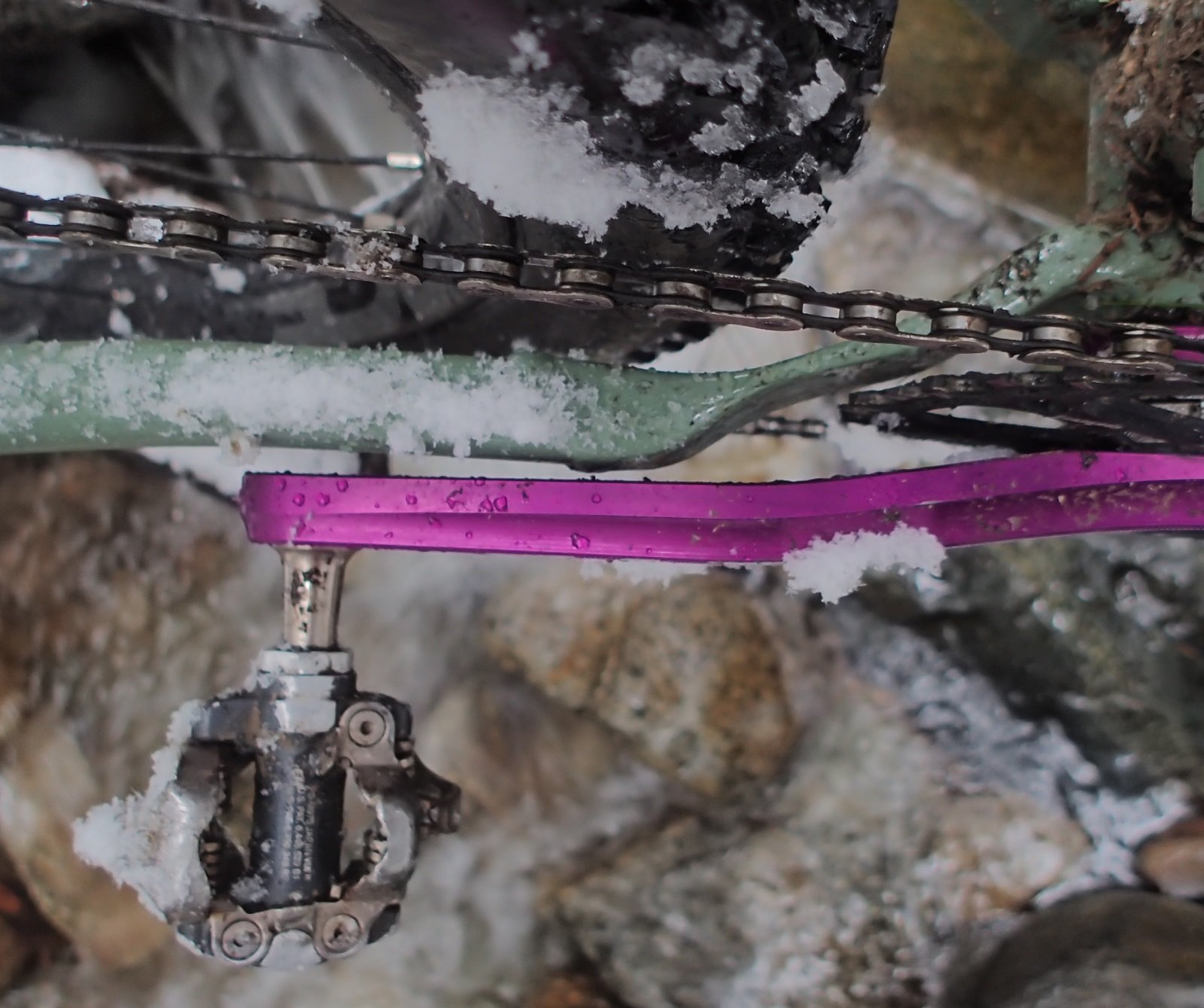
With a 2.8" Maxxis Rekon there's tonnes of tire clearance with the stays in their shortest mode. Despite the very tight crank clearance I had no issues with contact riding the Chameleon. Photo: Andrew Major
There is a bit of movement in the back end when hammering out of the saddle. That's not me calling the Chameleon "Flexy". Any time I read about how 'efficient' a hardtail is my back starts to ache and I'm also not saying I feel like I'm losing any power on the trail.
It's a nice sensation. The closest bike I'd relate it to personally is Kona's Ti Explosif. It isn't flexy - front or rear - but it dances through rough terrain a lot more pleasantly than most short-stay rigid frames. All that for a weight that's a couple pounds lighter than steel bikes with comparable geometry and pricing.
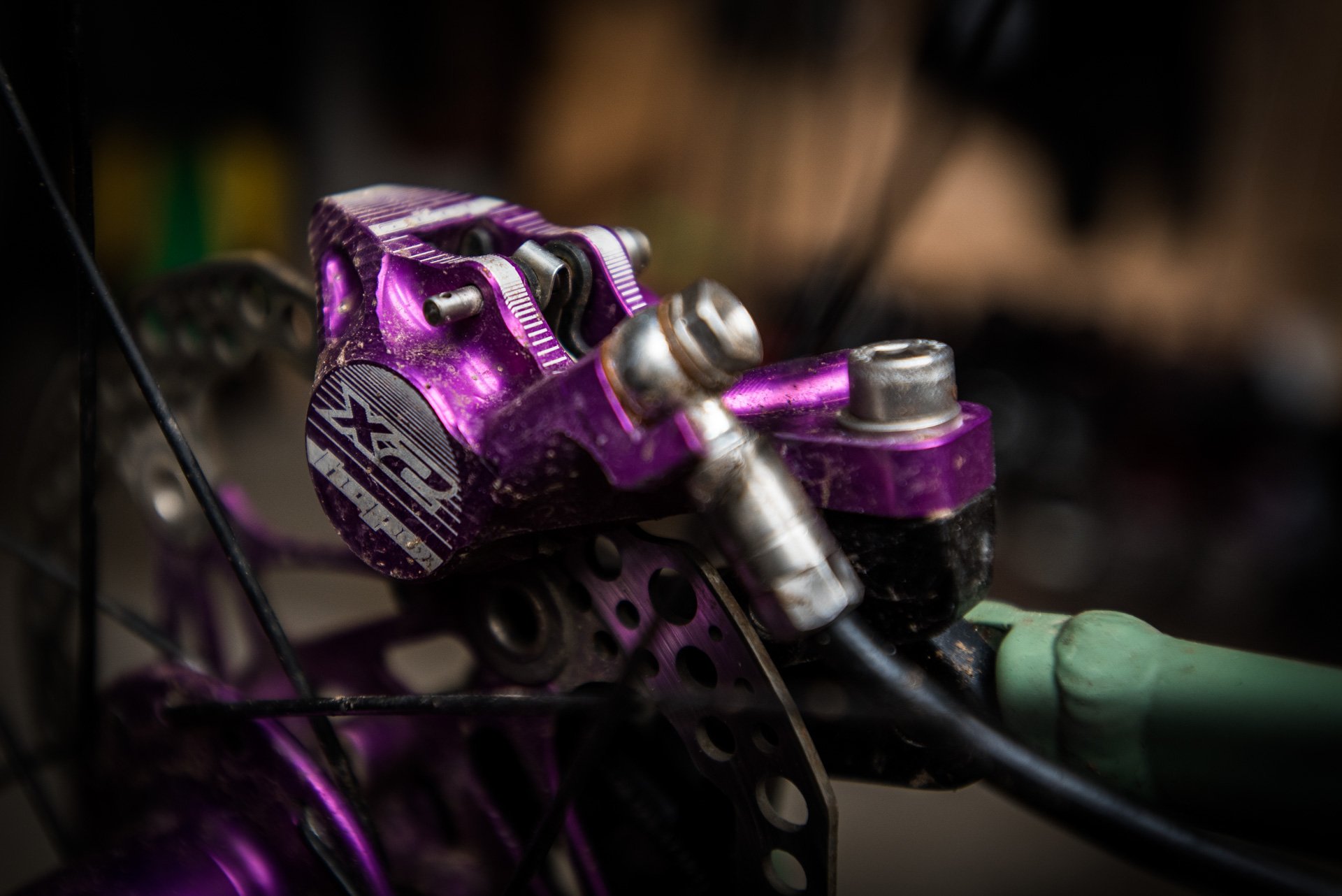
The Hope Tech 3 levers feel amazing. E4 four-piston caliper up front and X2 two-piston in the back. Purple! Fully serviceable with all small parts available. It's too bad Santa Cruz doesn't offer a full-Hope build version of the Chameleon.
Fork Travel vs Bike Value
From my experience with the Honzo, which is also spec'd with a 120mm fork, I'd suggest most of Santa Cruz's customers would be happiest running longer travel forks than what are coming with stock builds.
In my opinion, this makes the higher end R-Kit a significantly better value since the stock Fox Float Rhythm 34 fork should be an easy rod-swap away from being a 140mm fork. On the other hand, the D-Kit's basic Recon is a 120mm only affair, leaving a Chameleon rider wanting to maximize their budget experience in a position of eventually having to shell out for a new fork.
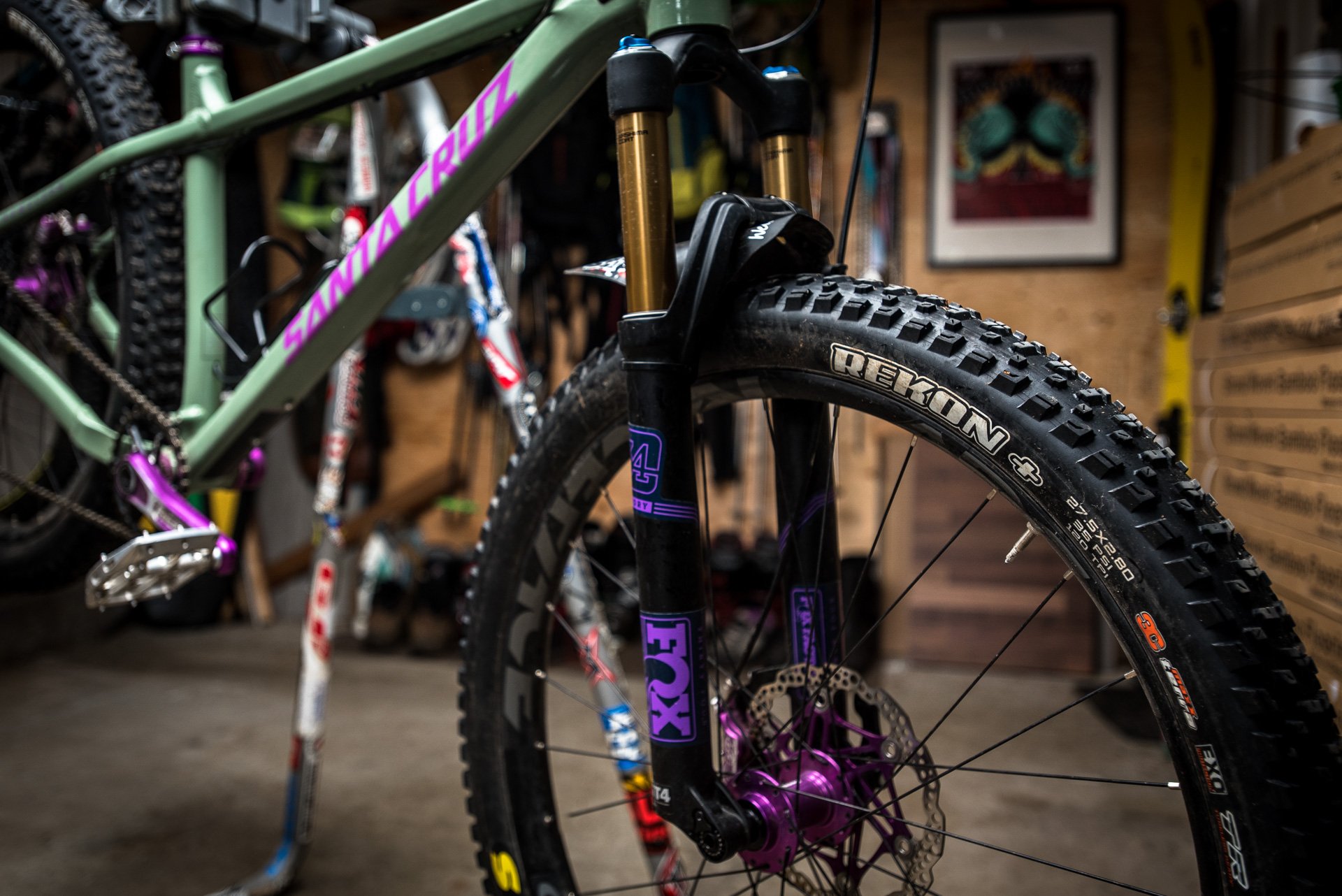
If the Chameleon was my bike I'd bump the 130mm Fox Float up to 140mm travel. No weight penalty, more travel, slightly higher BB.
Due to a lack of 27+ compatible forks with 140mm travel, this would mean increasing the price of both models. I'm a big fan of Fox suspension - I had a great experience this year with their OE-only Float Performance Elite FIT4 - but I'd strongly advocate equipping the Yari RC at both price points and differentiating the higher end R-Kit with an upgraded GX drivetrain.
Yes, that will increase the price of both build kits but as it stands now if I was still buying for a shop I would not be bringing in the D-Kit build. The R-Kit is simply a better and more adaptable long term value.
I think the new Chameleon is awesome - see the header below on single speeding - and I suspect Santa Cruz is going to sell a surprising percentage of these bikes as frame only. The first run of frames have gone to building bikes but anyone hungry for a Chameleon frameset should put in an order in with their Santa Cruz dealer.
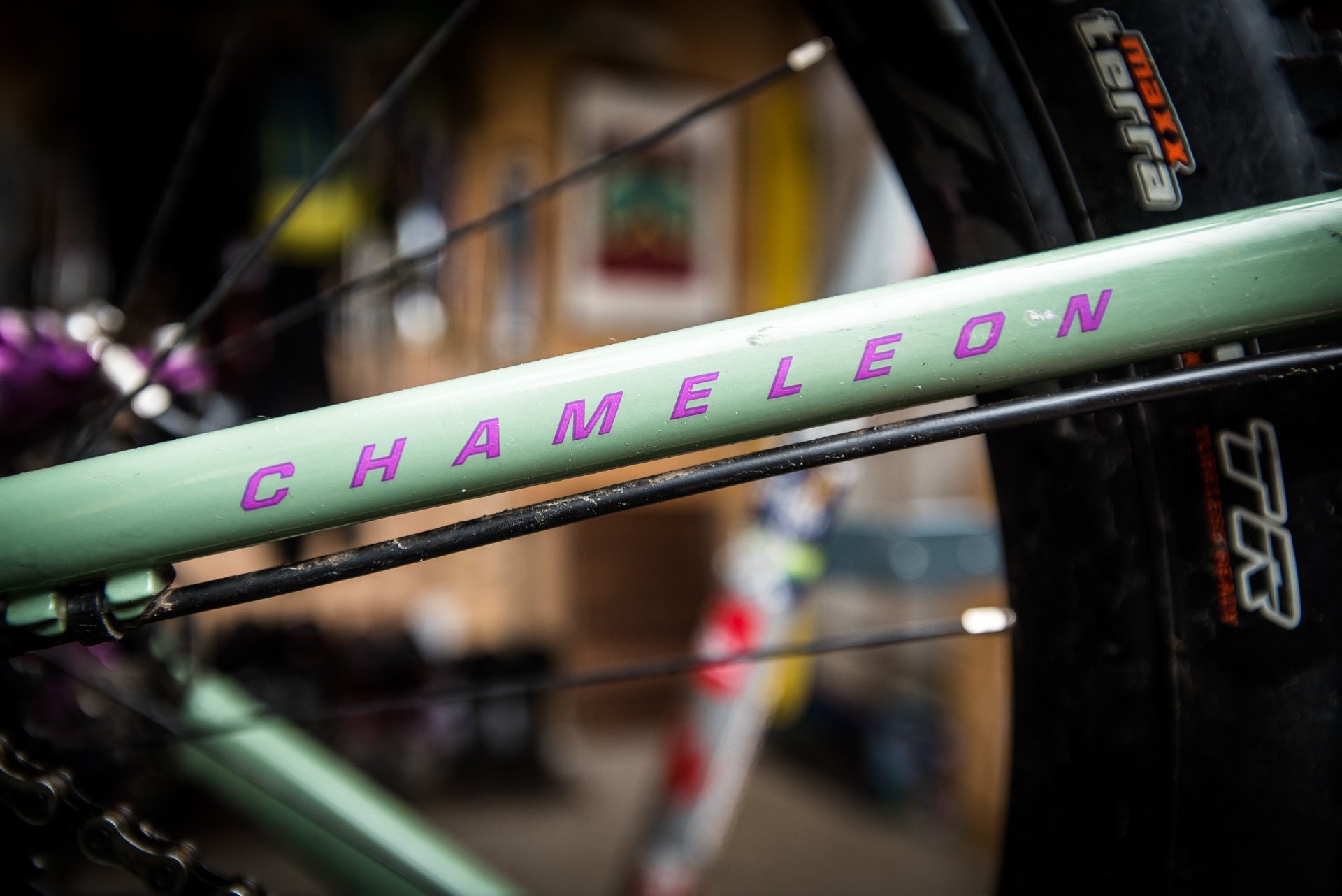
The Chameleon name has been around since the days before disk brakes. It's always been a do-everything hardtail open to racing XC, riding high skinny ladders, or just ripping trails with friends.
History
The first Chameleon I can remember coming across was equipped with XT V-brakes, a Marzocchi Z1 fork, ceramic Mavic 521 rims and a sweet powder blue paint job. If I had to guess I'd say that was in 1998. It was a cool bike. As the proud owner of a similarly spec'd Giant ATX 890 Team Tomac, it didn't seem to be all that innovative.
Fast forward a couple of years and it was the bike that changed how I thought about aggressive hardtails (I've had one of those in my stable ever since then). On my first visit to the North Shore I happened by a tiny shop called Steed Cycles with an entire ceiling of bright green, orange, and yellow Santa Cruz frames. Bullits, Hecklers, Superlights, and Chameleons, oh my!
I couldn't track down a photo, but there on the floor was Kim Steed's personal Chameleon. Marzocchi fork with a massive bolt-on aftermarket arch. 3" Nokian Gazzolodis up front with a 2.6" in the back. Bright yellow Mavic rims (or were they green Double Tracks?) Hayes disk brakes. Santa Cruz had developed an add-on disk mount to interface with the horizontal dropouts which positioned the brake caliper below the chainstay - unlike anything on the market. The bike blew my mind.
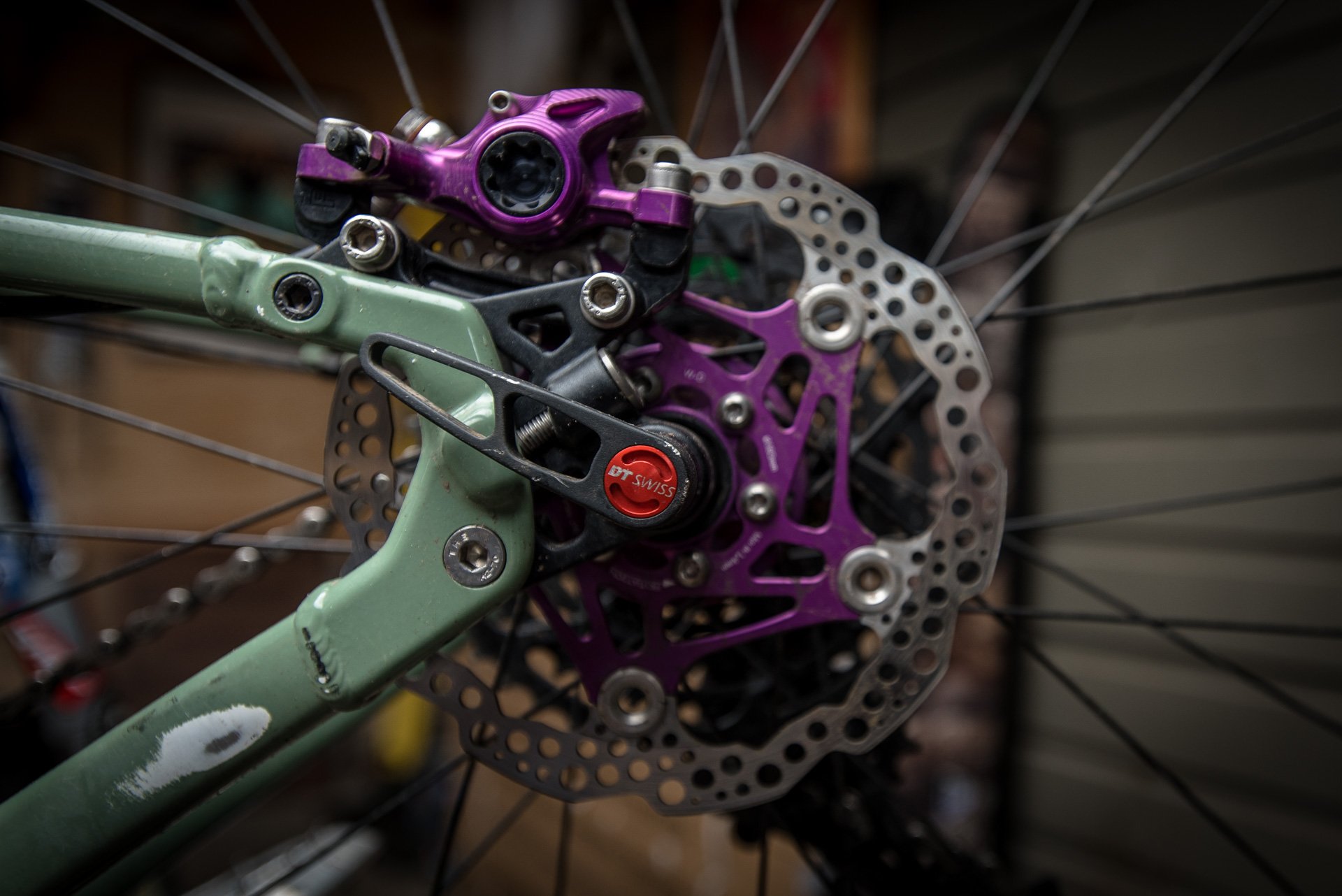
The previous generation Chameleon V6 also used a two bolt dropout configuration. The big visible difference is the rear racing chaintug bolt visible above the axle.
Single Speeding
Single speeders rejoice! The Chameleon is light, slack, forgiving (for a hardtail) and comes equipped with a sleek rotating dropout system to tension the chain for single speeding. It takes the hard decision away from riding a super fun rig like a Honzo, ROS, or Nimble-9 versus single speeding on a lighter SS rig with road geometry.
The dropouts work by loosening the mounting bolts and then turning the chaintug bolts to tension the chain.
The stock dropouts and derailleur hanger work perfectly for single speeding; however, for those that already own a high end set of SS-specific hoops, there's an additional factor to be excited about. While the Chameleon's 'geared' dropouts are 148-Boost there are an additional set of super clean looking SS-specific dropouts that are 142 x 12!
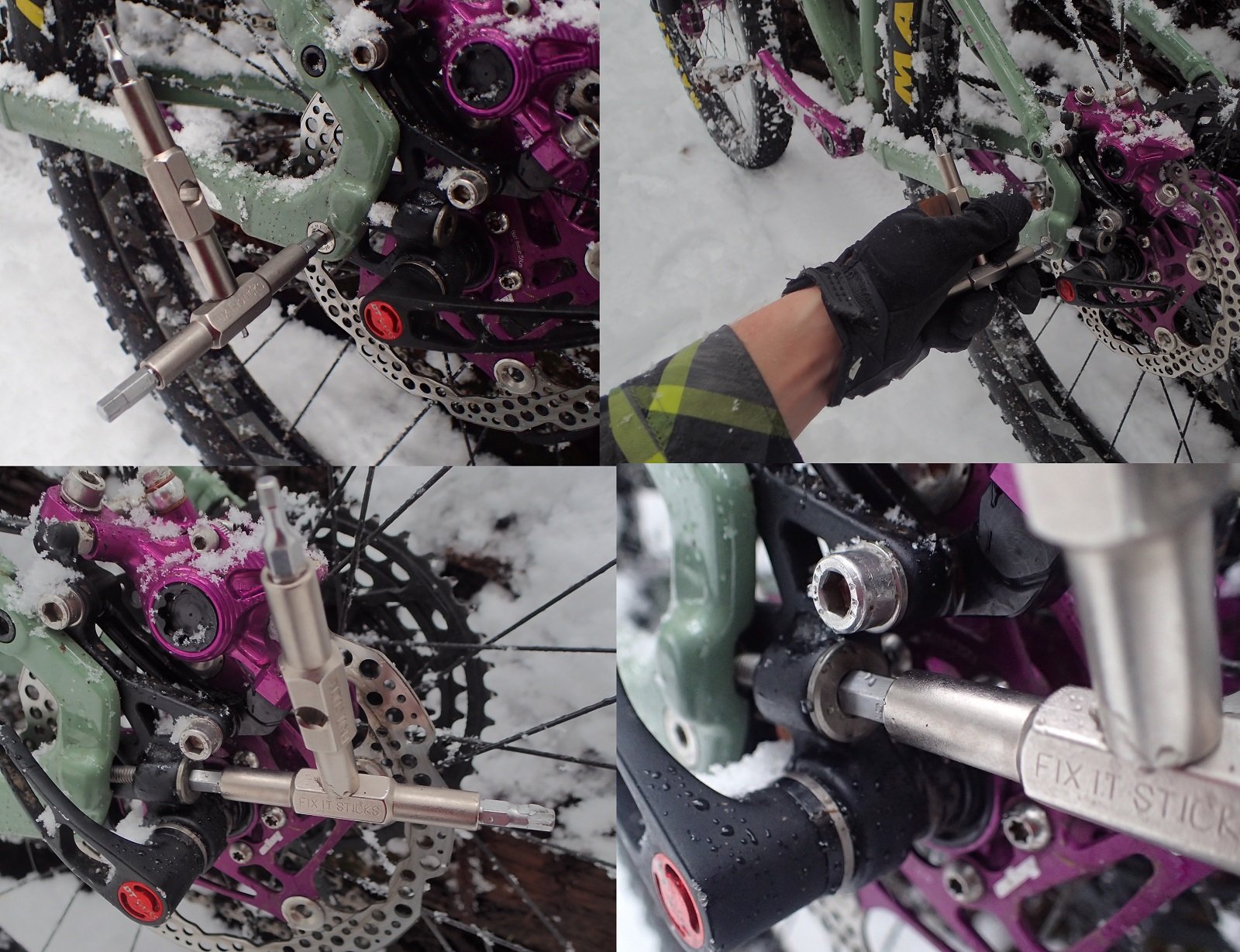
Loosen the dropout mounting bolts and turn the chaintug bolts to adjust wheelbase/tension the chain for single speeding. There is 15mm of wheelbase adjustment. Photo: Andrew Major
I didn't have the chance to test the Chameleon with one gear so my opinion is based off of riding other single speeds with almost identical geometry as well as pedaling the Santa Cruz with its SRAM/Hope drivetrain.
The dropout system is as clean as anything I've used.
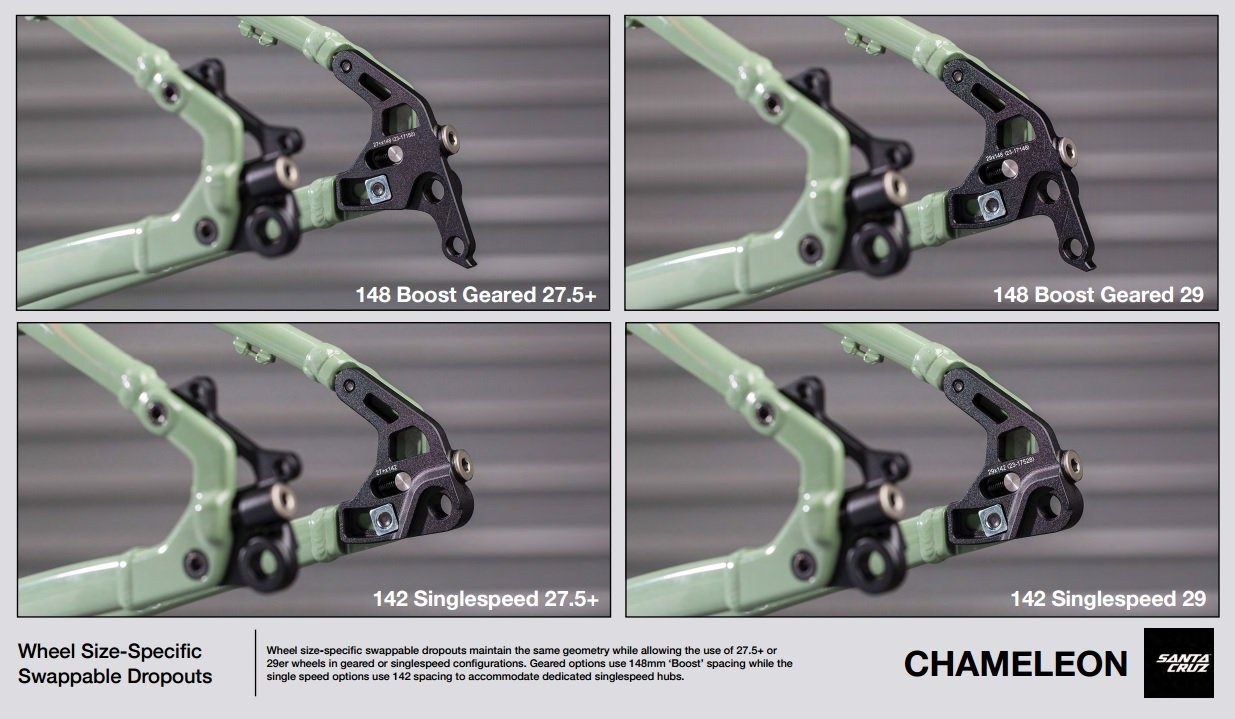
The stock 148x12 Boost dropouts work perfectly well for single speeding, of course. However, for those looking for a cleaner look, or trying to use existing high end 142x12 SS-specific wheels, a separate single speed dropout kit is available.
Bike Packing
Yes, you can put a rack on that. Get some p-clamps if there are no mounts. - Surly Bikes
Oh, I know what you're thinking, hardcore bike packing guy. It isn't steel. It doesn't have a million frames bosses for mounting the kitchen sink. Actually, it has four bosses. Two pairs. One above the down tube. One below the down tube. The Chameleon has a tiny front triangle that isn't at all optimized for the maximum size custom frame bag.
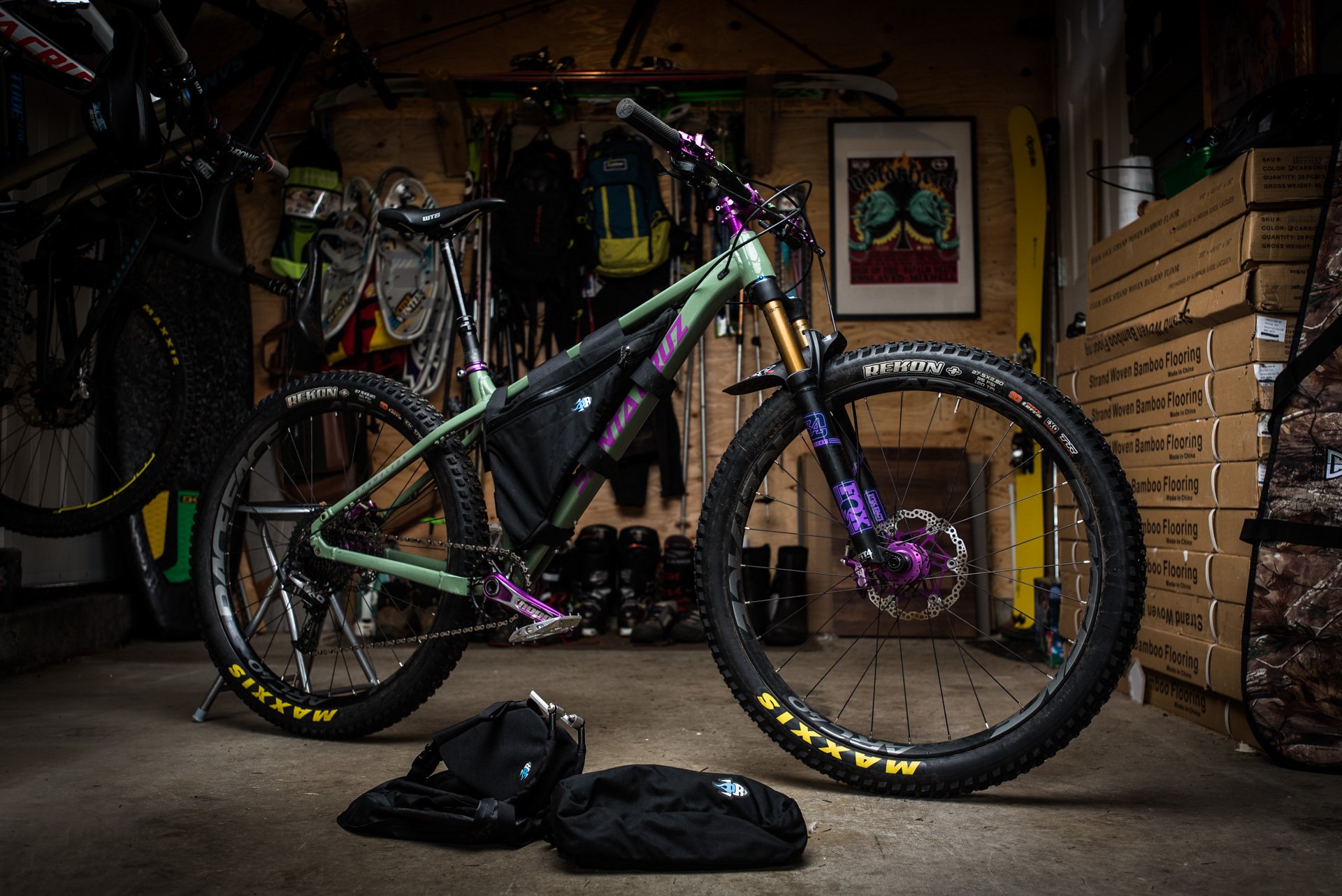
The Chameleon is up for anything and Santa Cruz had the custom Porcelain Rocket frame bags made to prove it.
The Santa Cruz Chameleon offers a comfortable ride for a hardtail, wheel size options, easy single-speed-ability in an emergency, and the thin square shape of the top tube is very ergonomic for portaging.
There are an infinite number of gravel and mountain bikes designed with bike packing in mind. On the other hand, optimized or otherwise, the Chameleon is up for anything and it is a ridiculous amount of fun for all those non-bike packing rides.
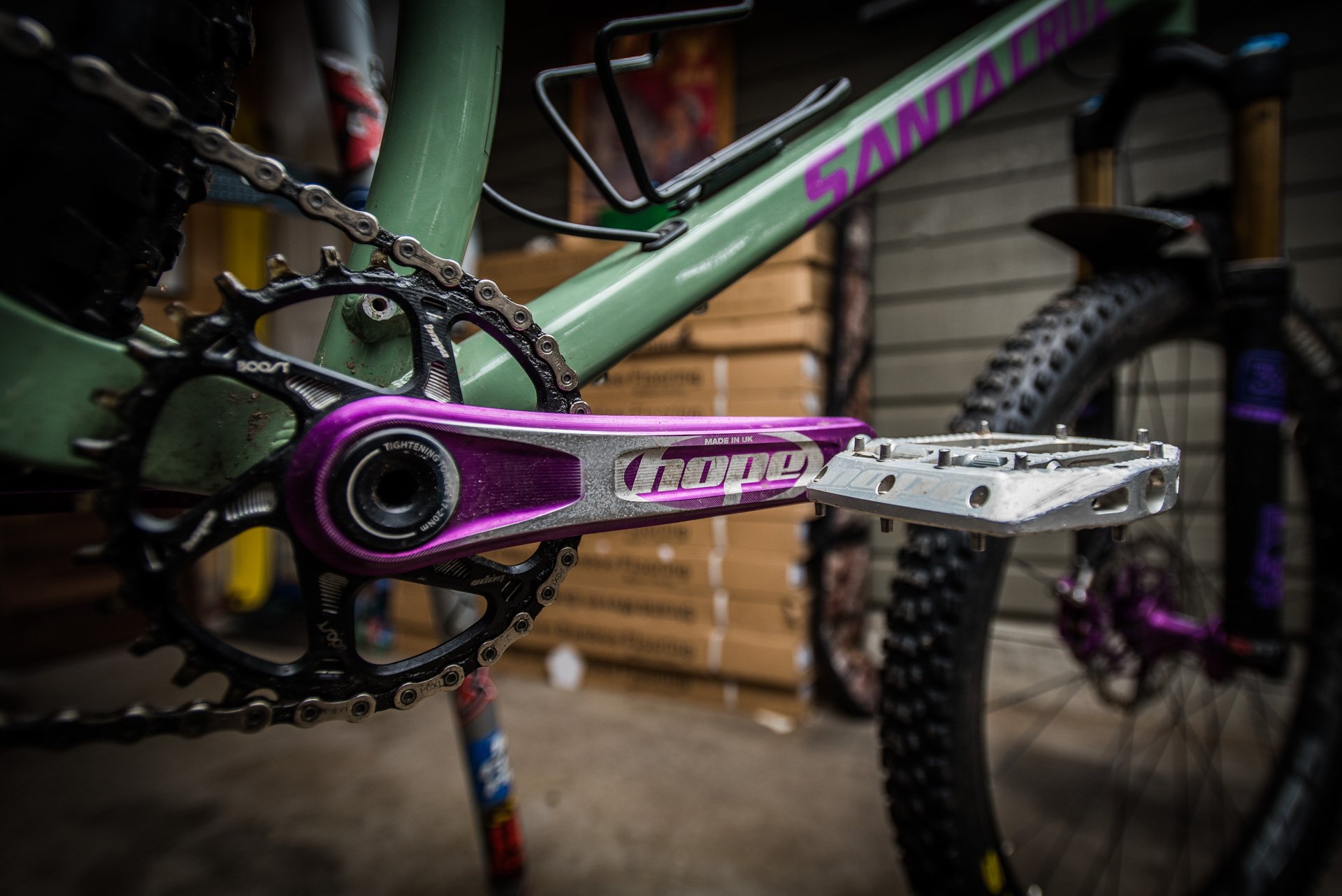
Drawn, formed, shaped, machined. There are a lot of smooth curves on the all-aluminum hardcore Hope-equipped hardtail.
Chameleon Conclusion
This wasn't a long term test but after a couple of rides, I'm confident that the Chameleon likes to dance and is surprisingly spry for an aluminum bike. The rest of the spec is all custom and doesn't reflect the budget build options Santa Cruz is selling with the fade-green-and-purple machine. I'll definitely say that the Chameleon wears the full Hope raiment well.
I'm excited for this bike. On one level, sure, it's another hardtail. On the other hand, it's a highly adaptable machine with a strong heritage of just say yes: race, ride or roam. It's the new frame I didn't know I needed this year that checks all my boxes for an aggressive, versatile, single speed capable hardtail.
Chameleon 'D Kit' : $1599 USD | $2249 CAD | 29lbs 29'er | 29.5lbs 27+
Chameleon 'R Kit' : $1999 USD | $2749 CAD | 27.7lbs 29'er | 28.6lbs 27+
Chameleon Frame Only : $749 USD | $1099 CAD | 4.6lbs







Comments
David Álvarez
7 years, 1 month ago
Though not the best picture, these are the horizontal dropout disc brake adaptors that go below the chainstay. My friends used to tell me I was crazy for running them that way, like it was my choice!
The picture actually shows the bike mounted with v-brakes, but you can clearly see the caliper bosses and how the caliper would be quite below the chainstay.
Reply
Andrew Major
7 years, 1 month ago
Ha! It's even lower than I remember. Thanks David!
Reply
Pete Roggeman
7 years, 1 month ago
So sick! I love those old RF turbine cranks in pewter.
Reply
Andy Eunson
7 years, 1 month ago
Nice to see a normal 73° seat tube angle too. Steep sta might be ok for some riders and some bikes where the rear sags more than the front meaning the actual seat angle is less than static.
Reply
Andrew Major
7 years, 1 month ago
Definitely my preference and it fit me very well even with the taller fork. Lots of super steep STA options (like Chromag) for folks that prefer that fit.
Reply
LWK
7 years, 1 month ago
Andrew, can you comment a bit further about what sort of folks/riders might prefer the steeper STA? asking because my older Stylus has 70 STA. Its a bit of a bear to pedal because knees are always well behind the pedals (although my standing climbing has greatly improved!). but as alluded to above all the new Chromags are 75 STA and so I dont know if I'd just be exchanging one issue for another if I were to move to a new frame.
Reply
Andrew Major
7 years, 1 month ago
Hi LWK, apologies for the delayed response.
It is a bit hard to fully qualify because a huge factor in seat angles is personal preference. On a full suspension bike it is a given that as climbs get steeper the seat angle gets slacker (more sag rear / less sag front) but on a hardtail the variations in static geometry (climbing) are pretty minimal and if actually the sagged seat angle is - as Andy noted - steeper than static.
Where that leaves guys like Andy and myself who have fairly long femurs and a preference to not be right over the bottom bracket is that many of the new geometry frames have STAs that are steeper than our preference. Since the vast majority of good dropper posts have no or little offset this is not something that can be easily corrected.
A 70-degree STA is slack for sure. Do you ride clipless pedals or flats? Is your bar significantly lower than your saddle? These things definitely have a large effect as well.
I prefer my cleats quite rearward in my shoes which may affect my fit as well.
Reply
LWK
7 years, 1 month ago
thx, hardly a delayed response! agree re FS bikes. My FS bike is 73 STA and I am quite happy with that. I have relatively long legs but average height (5'11") and I ride flats. I'm on a size L frame regardless of brand/model but I've always been able to make pretty much any bike work for me - not super fussy re fit details. So I suspect I'd be fine. agree its difficult to ask questions and offer advice about fit on the internet!
Reply
DMVancouver
7 years, 1 month ago
I'd be interested to hear more about a direct comparison to your Honzo. At 7 lbs with a steep STA and short rear end, do you find your Honzo offers much more in the way of additional compliance or vibration damping over the aluminum bike? It sounds like you were quite happy with the ride on on the Chameleon.
I have a Kona Taro (alloy Honzo) with a nice build and I have often wondered if the steel ride of the Honzo warrants the additional 2.5-3 lbs.
Reply
Andrew Major
7 years, 1 month ago
Preamble:
I feel I need to preface this reply by saying the best bike is the one you own - unless it isn't. I'm not trying to be negative but to nuance the differences.
I'm also ignoring for a second that I'm only personally interested in hardtails with a provision for chain tensioning single speed (Taro/Honzo Alloy are out as choices for me).
........
Reply:
I wouldn't call a Taro an aluminum Honzo. My brief experience with the bike (and I know two people who owned one who'd back me up) is that it's a bit noodley. The later gen aluminum Honzo, on the other hand, has a stiff front triangle (like the steel).
I have a '13/'14 steel Honzo and it is significantly heavier and it is a bit harsher ride than the Chameleon. On the other hand the '15 and '16/'17 steel Honzos dropped some weight and also are nicer riding bikes thanks to more vertical compliance in the back end.
Comparing a new '16/'17 steel Honzo to this '17 Chameleon is favourable. Both bikes have slack & stiff up front - ready to roll into steep terrain - but offer a lot more pleasant ride thanks to compliance put back. I think that combination of front-centre stiffness and rear-centre compliance should be the goal of hardtail design.
To answer your question. If you like your Taro, it has good geo - ride it. If you're thinking it isn't doing something then I think the new Honzo (or a Chameleon) is a better riding platform. Also, some of the weight difference is the sliding dropouts which give you adjustable wheelbase and the ability to SS.
Hopefully that is helpful?
Reply
Andrew Major
7 years, 1 month ago
Apologies for the typos. With no edit function I'm either going to have to up my phone game or only type long replies from my computer!
Reply
DMVancouver
7 years, 1 month ago
Cool, that's great info. Thanks. I guess the moral is that aluminum should not be ruled out for a nice-riding hardtail.
Reply
Andrew Major
7 years, 1 month ago
Exactly! Design is at least as important as materials.
Reply
Andrew Hewitson
7 years, 1 month ago
Reply
jeffgicklhorn
6 years, 10 months ago
Love the look with the frame bag installed. I would love to see more companies making frame bags available for hardtails like this, similar to what Salsa already does for some of their frames.
Reply
natbrown
7 years, 1 month ago
Hey Andrew, is the headset really a press in type? Their site lists it as integrated. Not trying to be a pain, just clarifying.
Reply
Andrew Major
7 years, 1 month ago
Hi Nat,
Good catch. It is Integrated not Internal. A mistake on my part pulling the V6 spec and making an assumption based on the Hope headset I was running. I've corrected it.
Thanks,
Reply
JonnyO
7 years, 1 month ago
Awesome build! Build cost?
Reply
Andrew Major
7 years, 1 month ago
Your preferred Santa Cruz dealer could easily prove it for you... I don't have a guesstimate...
It's' everything Hope including the cassette; SRAM 1x11 shifter, derailleur and chain; RaceFace Arc 40 rims; tires; Reverb...
Reply
Andrew Major
7 years, 1 month ago
*price
Also a Fox Float 34 FIT4.
Reply
realityfilter
6 years, 11 months ago
I would like to know if the scratches on the left chainstay that are very visible on a picture above are caused by wearing (shoe) or from an accident. Andrew, how do you evaluate longevity of this bike with this small crank clearance you mentioned above?
Reply
Andrew Major
6 years, 11 months ago
In this case the scratches came with the bike. It's a personal ride I borrowed for a few rides.
I'd guess shoe wear. I'm a notorious heal rubber and have similar wear on most bikes I ride (not to mention cranks).
I don't follow the second question (longevity) there is no contact between the cranks and frame they just very close. It's just something to keep in mind re. crank shape.
Reply
bertroot
6 years, 11 months ago
What size chainring do you have on this as clearance looks slim. I was going to use a Hope 32 tooth Boost ring on mine but not sure that will go. Also do you have BB spacers on this and how many on each side?
Reply
bertroot
6 years, 10 months ago
Fitted the 32 Boost and it fits ok. One spacer on the drive side and crank clearance is about 3mm on drive side and 5mm on non drive side.
Reply
Andrew Major
6 years, 10 months ago
Is it a round or oval 32t?
Reply
bertroot
6 years, 10 months ago
Andrew Major, it is a round one, think an oval would work though as there is enough space.
Also worth knowing that the seat post clamp is a 36.4 and not the usual 34.9.
Reply
Andrew Major
6 years, 10 months ago
@bertroot it's a 35mm seat post (not a 31.6) which necessitates the 36.4mm clamp?
Reply
bertroot
6 years, 10 months ago
Andrew the post is a 31.6 as I have fitted a Thomson one I had lying around but the tube must be thicker that it sits in. Jungle confirmed it is a 36.4 clamp, same size as Treks I have built in the past.
Reply
Andrew Major
6 years, 10 months ago
Interesting! Playing it safe with wall thickness or maybe just matching what they're doing in carbon?
Thank you for following up.
Reply
issya
4 years, 11 months ago
If you were to put a 130mm fork on the 29 version, would you go with 44mm or 51mm rake?
Reply
Please log in to leave a comment.